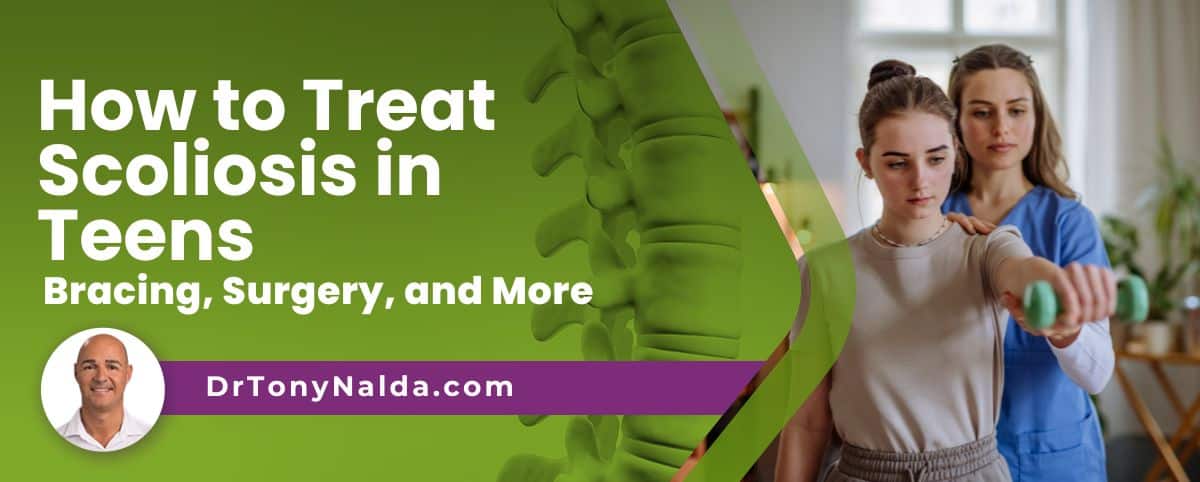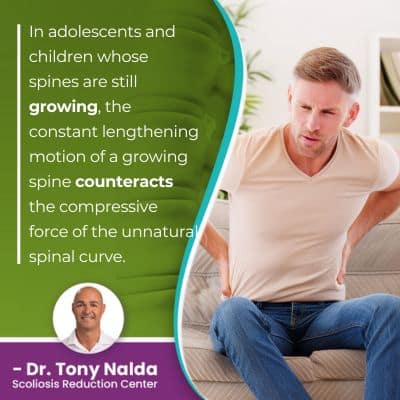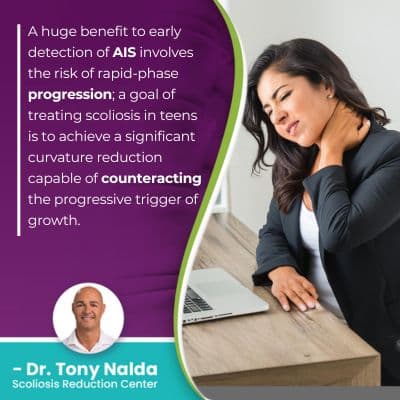How to Treat Scoliosis in Teens: Bracing, Surgery, and More

Scoliosis affects all ages but is most prevalent in adolescents between the ages of 10 and 18: adolescent idiopathic scoliosis. The most important thing to understand about scoliosis in teens is that it's progressive and progression is triggered by growth spurts.
The best way to treat scoliosis in teens is by diagnosing it early and treating it proactively. With early detection, adolescent idiopathic scoliosis can be highly treatable, and not all cases of scoliosis need surgery.
Unnatural spinal curves aren't always easy to diagnose, and when it comes to teens, there are some additional barriers to early detection.
Table of Contents
Diagnosing Scoliosis in Teens
Scoliosis causes the spine to bend unnaturally to the side and twist, making it a 3-dimensional condition.
The issue with adolescent idiopathic scoliosis (AIS) is that considering the age group it affects, adolescents between the ages of 10 and 18, transparency and compliance can be challenging.
Adolescents aren't always known for their transparency, so even if a teen notices some subtle changes in their posture that are common indicators of scoliosis, they aren't always known to share these findings; most teens want to fit in, they don't want to stand out, and if they notice differences, they are often concealed under baggy clothing.
The adolescent slouch can also disguise postural changes caused by scoliosis as this age isn't exactly known for proper posture.
In order to reach a diagnosis of scoliosis, an unnatural sideways bending and twisting spinal curve with a minimum Cobb angle measurement of at least 10 degrees, but before seeking out an assessment by a medical professional, signs have to be noticed that alert patients to the need for assessment, diagnosis, and treatment.
Despite the many benefits associated with early detection of AIS, it's not always easy to accomplish.
In addition, adolescent idiopathic scoliosis isn't commonly painful, at least not as painful as adult scoliosis can be.
Scoliosis Pain
Scoliosis pain can affect adolescents and children, but this is more in the form of muscle pain, and when it comes to back pain and/or pain that radiates into the extremities due to nerve compression, these are condition effects more closely associated with adult scoliosis.
 Scoliosis doesn't become a compressive condition until skeletal maturity has been reached; it's compression of the spine and its surrounding muscles and nerves that causes the majority of condition-related pain.
Scoliosis doesn't become a compressive condition until skeletal maturity has been reached; it's compression of the spine and its surrounding muscles and nerves that causes the majority of condition-related pain.
So while adolescents can experience a degree of muscle pain due to strained, sore, and unbalanced muscles, the kind of pain that leads to an early diagnosis and treatment isn't often a part of adolescent idiopathic scoliosis.
In adolescents and children whose spines are still growing, the constant lengthening motion of a growing spine counteracts the compressive force of the unnatural spinal curve.
The lack of scoliosis pain, subtlety of postural changes when mild, and lack of functional deficits when mild can be a barrier to early detection.
So scoliosis can range widely in severity from mild scoliosis to moderate and severe to very severe scoliosis; the more severe a condition, the larger the size of the unnatural spinal curve is, and the more likely it is that its effects are going to be noticeable, and when it comes to teens, we're talking about postural changes.
Posture and Teen Scoliosis
The main sign of scoliosis in children and teens to look for involve postural changes; often, the earliest signs of scoliosis are uneven shoulders and hips, and additional changes can include:
- An uneven eye line
- A head that seems uncentered over the torso
- Uneven shoulder blades
- Development of a rib cage arch
- Arms and legs that hang at different lengths
- Clothing seeming ill-fitting
Scoliosis will also cause a teen's walk to change, their balance, and their coordination, so knowing these condition effects can help reach early detection.
Progression and Scoliosis in Teens
The reason early detection of scoliosis has so many treatment benefits is because of a progressive condition, the nature of scoliosis is to get worse over time.
Scoliosis ranges from mild to very severe, and this is also the condition's progressive line; only proactively treatment can work towards counteracting the condition's progressive nature.
When scoliosis progresses in teens, the size of the unnatural spinal curve is increasing, as are the condition's uneven forces, and their effects.
So for a typical teen, postural changes will become more noticeable, along with changes to movement.
If left untreated, scoliosis is virtually guaranteed to get worse at some point, and as scoliosis progresses, it gets more complex to treat, hence the benefit of early detection and intervention.
Teen Scoliosis and Early Detection
As a progressive condition, the best time to start scoliosis treatment is always now, and this is regardless of age or condition severity.
Adolescent idiopathic scoliosis, however, is the type most at risk for rapid-phase progression; progression is triggered by growth spurts, and adolescents are facing the rapid and unpredictable growth spurts of puberty.
With early detection, conditions are diagnosed before significant progression has already occurred, and as progression makes the spine increasingly rigid, it makes the spine less responsive to treatment, and it can also make it difficult for some patients to perform key therapeutic exercises as part of treatment.
Early detection means that treatment can be started immediately following a diagnosis, when conditions are at their mildest, most treatable, and before condition effects are well established.
A huge benefit to early detection of AIS involves the risk of rapid-phase progression; a goal of treating scoliosis in teens is to achieve a significant curvature reduction capable of counteracting the progressive trigger of growth.
Holding a reduction throughout growth is key, and here at the Scoliosis Reduction Center, teens benefit from a proactive conservative treatment approach that's started as close to the time of diagnosis as possible.
Conservative scoliosis treatment is integrative and combines the power of multiple scoliosis-specific treatment disciplines that can impact conditions on every level.
Physical Therapy and Scoliosis Exercises
 Physical therapy and scoliosis exercises are an important facet of treatment in a number of ways: by preparing the spine for treatment, by strengthening the spine's surrounding muscles so they can optimally support and stabilize it, addressing poor posture, any muscle imbalances, and activating certain areas of the brain for improved brain-body communication.
Physical therapy and scoliosis exercises are an important facet of treatment in a number of ways: by preparing the spine for treatment, by strengthening the spine's surrounding muscles so they can optimally support and stabilize it, addressing poor posture, any muscle imbalances, and activating certain areas of the brain for improved brain-body communication.
Physical therapy and scoliosis exercises are also part of leading a scoliosis-friendly lifestyle and sustaining long-term treatment results.
Chiropractic Care
While the complex nature of scoliosis is beyond the scope of general chiropractic care, a scoliosis chiropractor knows the spine, how scoliosis affects it, and how best to heal and stabilize the spine.
As a structural spinal condition, scoliosis has to be mainly impacted on a structural level to reach corrective treatment results.
A variety of chiropractic techniques and manual adjustments can be applied to work towards adjusting the position of the curve's most-tilted vertebrae at its apex back into alignment with the rest of the spine, and which structural support of stronger surrounding muscles, the spine's structural changes can be stabilized and supported.
Scoliosis Bracing in Teens
Scoliosis braces are known as particularly effective on growing spines so is a regular facet of scoliosis treatment in teens.
A corrective brace like the ScoliBrace can help augment corrective treatment results by pushing the spine into a straighter and corrective position, and when combined with other types of treatment, they can all work together for better results that are sustainable and long-term.
The biggest challenge to brace efficacy is compliance; again, most teens don't want to stand out and wear a brace, and no brace can be effective if it's not worn exactly as prescribed.
Rehabilitation can mean guidance on how to lead a scoliosis-friendly lifestyle, continued chiropractic care, and the prescription of scoliosis-specific exercises custom-designed to further heal and stabilize the spine from home.
Conclusion
Scoliosis in children should always be taken seriously, particularly as a progressive condition triggered by growth, and when it comes to scoliosis in teenagers, this age group is the most at risk for rapid-phase progression due to puberty.
So the best way to reach early detection of adolescent idiopathic scoliosis is through awareness of the condition's early telltale signs.
While early detection doesn't guarantee treatment success, it does increase the chances if an early diagnosis is responded to with a proactive treatment approach.
As the leading spinal deformity among school-aged children, screening is important, and particularly there is a family history of scoliosis, this is considered a risk factor that warrants regular early screenings started prior to the first pubescent growth spurt.
While each case is unique, if left untreated, scoliosis can continue to progress unimpeded, develop complications, and require invasive surgical treatment in the future.
Dr. Tony Nalda
DOCTOR OF CHIROPRACTIC
After receiving an undergraduate degree in psychology and his Doctorate of Chiropractic from Life University, Dr. Nalda settled in Celebration, Florida and proceeded to build one of Central Florida’s most successful chiropractic clinics.
His experience with patients suffering from scoliosis, and the confusion and frustration they faced, led him to seek a specialty in scoliosis care. In 2006 he completed his Intensive Care Certification from CLEAR Institute, a leading scoliosis educational and certification center.
About Dr. Tony Nalda
 Ready to explore scoliosis treatment? Contact Us Now
Ready to explore scoliosis treatment? Contact Us Now





